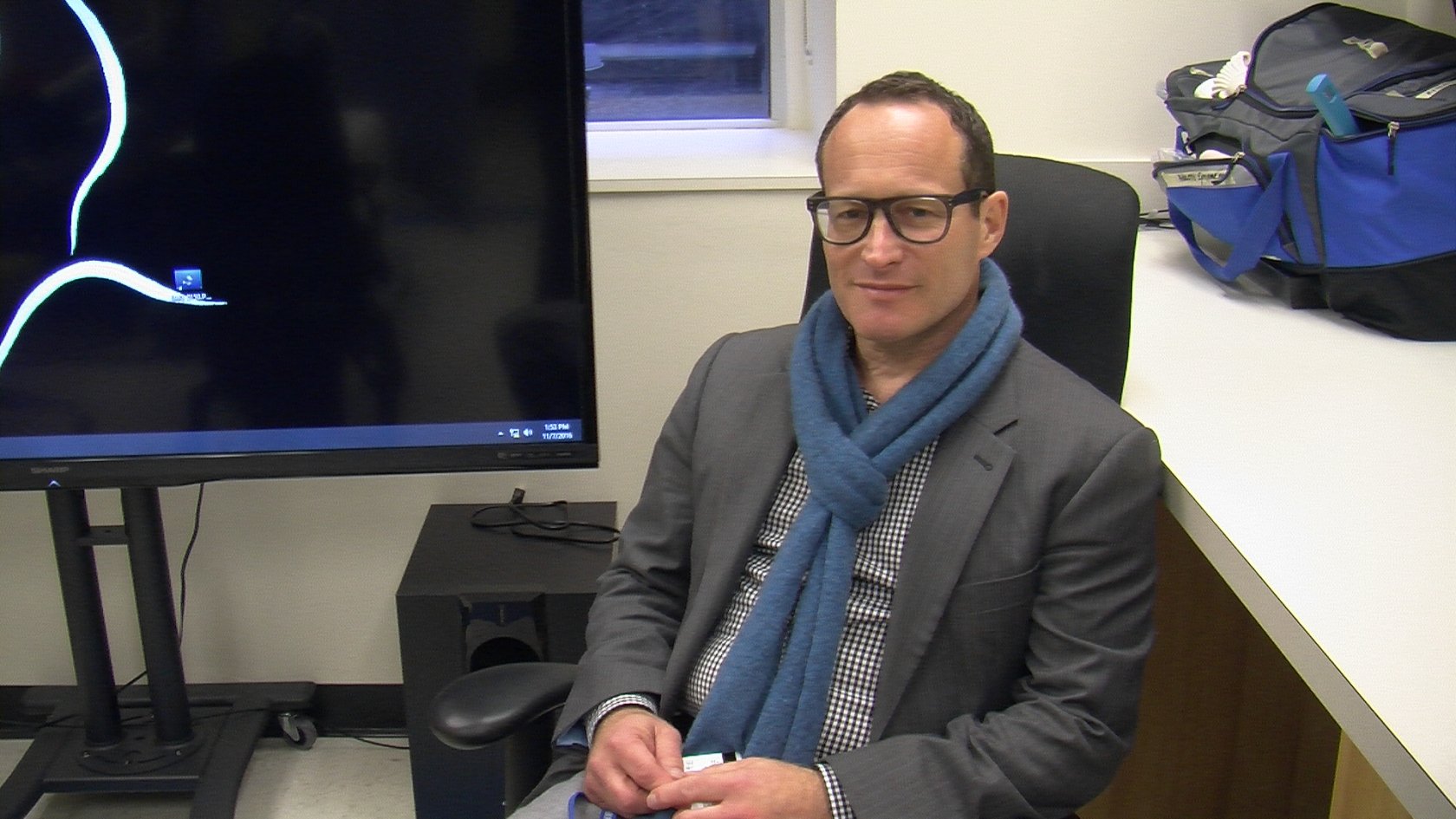By: Jared Swain
Press Start to Heal
The Therapeutic Benefits of Playing Video Games
It's the day before Election Day and Dr. John Krakauer's mind is crowded. The small plant at the bottom left corner of his desk dies of thirst as he eats Balducci's soup and sips tea.
On this day, he juggles reading emails, gathering notes, meeting with and rehabilitating patients, and answering questions from a college student. More importantly, he's booking a next day 6:30 a.m. flight to California. He has meetings with the American Society for Neurorehabilitation, the Society for Neuroscience, and Pixar.
This day comes two years after Dr. Krakauer, along with Omar Ahmad, Kat McNally, and Promit Roy, created an iOS game called I Am Dolphin, and redeveloped it for the sole purpose of stroke rehabilitation.
"It was a game we developed to get feedback on, so we could customize it for our patients," said Dr. Krakauer, professor of neurology and neuroscience at Johns Hopkins. "We found that gaming is the perfect crossroads for this and it might help people engage into their rehabilitation."
On this day, he juggles reading emails, gathering notes, meeting with and rehabilitating patients, and answering questions from a college student. More importantly, he's booking a next day 6:30 a.m. flight to California. He has meetings with the American Society for Neurorehabilitation, the Society for Neuroscience, and Pixar.
This day comes two years after Dr. Krakauer, along with Omar Ahmad, Kat McNally, and Promit Roy, created an iOS game called I Am Dolphin, and redeveloped it for the sole purpose of stroke rehabilitation.
"It was a game we developed to get feedback on, so we could customize it for our patients," said Dr. Krakauer, professor of neurology and neuroscience at Johns Hopkins. "We found that gaming is the perfect crossroads for this and it might help people engage into their rehabilitation."
Dr. Krakauer Speaks About Remaking I Am Dolphin for His Stroke Patients. (Video by: Jared Swain)
Doctors Discover The Healthy Way to Play
Video games receive a great amount of criticism for being an addictive, violent and distracting piece of technology. However, recent studies and research are suggesting that video games are just as beneficial as they are harmful in the fields of psychology, therapy and medicine.
In 2014, researchers and psychologists Isabela Granic, Adam Lobel, and Rutger C. M. E. Engels published an article to the American Psychological Association mapping out the psychological benefits of playing video games. The research concluded that the same themes present in children's play experiences (dominance, nurturance, anxiety, and growth, for example) are also explored in video games.
In 2014, researchers and psychologists Isabela Granic, Adam Lobel, and Rutger C. M. E. Engels published an article to the American Psychological Association mapping out the psychological benefits of playing video games. The research concluded that the same themes present in children's play experiences (dominance, nurturance, anxiety, and growth, for example) are also explored in video games.
Read the American Psychological Association's article about the benefits of playing video games
Everything that a child learns through regular non-digital play and interaction can also be taught through video game play. Depending on the game, video games provide benefits for healthy educational, emotional, motivational, and social development. Playing World of Warcraft, a complex and social role-playing game, could be socially healthy, while Bejeweled, a simple and non-social puzzle arcade game, could improve one's problem solving skills.
I think video games are fun. I play them. I'm not trying to make people not use them at all. They can educate in specific ways, connect with people and extend friendships. But video games are a tool. Why is it that kids will fight doing homework but spend hours playing video games with complex puzzles?
Violent action games are often under fire for being the pathway to violent behavior. However, Granic's research indicates that these action games, particularly shooters, contain a range of psychological development.
Carol McGinnis, Ph.D., is a pastoral counselor and assistant professor of counseling at Messiah College. She specializes in anger, anxiety, grief and stress. She uses Xbox 360 first-person shooters with clients who struggle with these emotions.
"Xbox shooters are a good way to express anger in a safe place," McGinnis said, who published a qualitative study on psycho-spirituality in first-person shooters. "The men talked more and women talked less. 75 percent of every game, people talked about something other than the game."
In her research and clinical sessions, McGinnis found that during online play, most players, men and women, were reluctant to engage with her until they heard her voice.
"Counseling is incredibly intimate. You have a lot of things that can come out," McGinnis said.
Carol McGinnis, Ph.D., is a pastoral counselor and assistant professor of counseling at Messiah College. She specializes in anger, anxiety, grief and stress. She uses Xbox 360 first-person shooters with clients who struggle with these emotions.
"Xbox shooters are a good way to express anger in a safe place," McGinnis said, who published a qualitative study on psycho-spirituality in first-person shooters. "The men talked more and women talked less. 75 percent of every game, people talked about something other than the game."
In her research and clinical sessions, McGinnis found that during online play, most players, men and women, were reluctant to engage with her until they heard her voice.
"Counseling is incredibly intimate. You have a lot of things that can come out," McGinnis said.

This infographic highlights the key facts from the 2015 Essential Facts About the Computer and Video Game Industry report, done by the Entertainment Software Association (ESA). (Graphic and statistics by: The ESA)
Motivation is another psychological pillar that is found in all video games. Video games can help boost self-esteem and teach the value of persistence and effort by setting specific goals. They offer immediate feedback after players complete their goals and, in turn, players perceive themselves as skilled, empowered and intelligent.
Video games sometimes use failure as a cognitive or motivational tool. Naturally, players become angry, frustrated, or sad when they experience failure. However, most players use this as inspiration to continue playing and also use foul language as a coping mechanism.
"Most of the time, cursing was done out of fun. Other times, it was just healthy frustration over performance," McGinnis said.
On a social level, video games have the ability to create a sense of community. McGinnis recalls one client that uses video games to connect with his brother overseas.
"He said to me 'my brother is in the military and it's hard for us to talk. We get online and play and we talk for like four hours," McGinnis said.
Video games sometimes use failure as a cognitive or motivational tool. Naturally, players become angry, frustrated, or sad when they experience failure. However, most players use this as inspiration to continue playing and also use foul language as a coping mechanism.
"Most of the time, cursing was done out of fun. Other times, it was just healthy frustration over performance," McGinnis said.
On a social level, video games have the ability to create a sense of community. McGinnis recalls one client that uses video games to connect with his brother overseas.
"He said to me 'my brother is in the military and it's hard for us to talk. We get online and play and we talk for like four hours," McGinnis said.
Dolphin and brain study pictures cover the walls of the BLAM lab at Johns Hopkins. Dr. Krakauer, Omar Ahmad, Kat McNally, and Promit Roy spent years studying the dolphins at the Baltimore National Aquarium. (Photo by: Jared Swain)
In Rehab, "Practice Makes Perfect"
Dr. Krakauer strived to tap into the motivational benefits of video gaming using the concepts from I Am Dolphin. He is interested in human movement in stroke patients. Particularly, he looks at how people control and handle movement in the arms and the legs.
"I like to look at what helps patients recover through movement and the theory of motor learning," said Dr. Krakauer, who received his medical degrees from Cambridge University and Columbia University.
He pondered over the ideas of repetition, motor learning, and the advancement of skills while creating the game.
"We all know that practice makes perfect, but we don't know why," Dr. Krakauer said.
Dr. Krakauer created his own laboratory to study motor learning and the brain's functions with movement. He founded the Brain, Learning, Animation, Movement lab, or BLAM. Krakauer created the lab in collaboration with designers, engineers, computer programmers and artists. He believes that this collaboration can lead to new discoveries about the brain.
In addition to the rehabilitation version of I Am Dolphin, Dr. Krakauer and the BLAM team developed a robotic arm sling, the Hocoma ArmeoPower, to assist patients with their movements. In some cases, the sling can take over a patient's movement.
"You can learn a lot about the brain without imaging it, lesioning it, or recording it," Dr. Krakauer said. "Along with robotics, video games have enormous potential to advance learning and rehabilitate."
"I like to look at what helps patients recover through movement and the theory of motor learning," said Dr. Krakauer, who received his medical degrees from Cambridge University and Columbia University.
He pondered over the ideas of repetition, motor learning, and the advancement of skills while creating the game.
"We all know that practice makes perfect, but we don't know why," Dr. Krakauer said.
Dr. Krakauer created his own laboratory to study motor learning and the brain's functions with movement. He founded the Brain, Learning, Animation, Movement lab, or BLAM. Krakauer created the lab in collaboration with designers, engineers, computer programmers and artists. He believes that this collaboration can lead to new discoveries about the brain.
In addition to the rehabilitation version of I Am Dolphin, Dr. Krakauer and the BLAM team developed a robotic arm sling, the Hocoma ArmeoPower, to assist patients with their movements. In some cases, the sling can take over a patient's movement.
"You can learn a lot about the brain without imaging it, lesioning it, or recording it," Dr. Krakauer said. "Along with robotics, video games have enormous potential to advance learning and rehabilitate."
Video Games Provide Intentional Healing
Many video games have already been developed across the globe with the specific intent of educating or rehabilitating.
The Center for Brain Health at the University of Texas at Dallas developed a virtual reality program called "VR Social Cognition Training" in 2014. This training is a ten-session, five-week, unscripted program that allows individuals on the autism spectrum to practice having conversations.
"For someone with autism, starting conversations is daunting," said Dr. Tandra Allen, one the project's clinicians. "In the VR, if you mess up, who cares? It's a practice."
The VR program is customizable to the user. It has the ability to adjust its settings to a person in order to influence motivation.
"It allows the person to be totally emerged and present," Allen said. "Your brain is tricked into thinking 'I'm emotionally invested. This matters."
The Center for Brain Health at the University of Texas at Dallas developed a virtual reality program called "VR Social Cognition Training" in 2014. This training is a ten-session, five-week, unscripted program that allows individuals on the autism spectrum to practice having conversations.
"For someone with autism, starting conversations is daunting," said Dr. Tandra Allen, one the project's clinicians. "In the VR, if you mess up, who cares? It's a practice."
The VR program is customizable to the user. It has the ability to adjust its settings to a person in order to influence motivation.
"It allows the person to be totally emerged and present," Allen said. "Your brain is tricked into thinking 'I'm emotionally invested. This matters."
Jane McGonigal, who holds a doctorate in performance studies, is a famous game designer and the Director of Games Research & Development at the Institute for the Future. She went as far as to develop a game for her own personal healing. After suffering a traumatic head injury in 2009, Dr. McGonigal created SuperBetter, as a means to help her fight post-concussion syndrome. Since then, the game, also known as Jane the Concussion Slayer, has been redeveloped to tackle depression, anxiety, chronic pain, insomnia and traumatic head injuries.
Dr. Dana Klisanin is an award-winning psychologist and CEO of at Evolutionary Guidance Media. She has designed Cyberhero League, a scout-like adventure game with a real-world twist. The players' objective is to achieve the United Nations' Sustainable Development goals.
"Some of our goals for Cyberhero League include promoting character strengths and virtues," Dr. Klisanin said. "These include altruism, empathy, and compassion."
Dr. Dana Klisanin is an award-winning psychologist and CEO of at Evolutionary Guidance Media. She has designed Cyberhero League, a scout-like adventure game with a real-world twist. The players' objective is to achieve the United Nations' Sustainable Development goals.
"Some of our goals for Cyberhero League include promoting character strengths and virtues," Dr. Klisanin said. "These include altruism, empathy, and compassion."
Video Games with the Intention of Healing from Across the Globe

Playing Against Cancer
At 12 years old, Steven Gonzalez from Houson, Texas taught himself iMovie, a 3D animation suite called Maya and many other programs to develop a multi-level video game called Playing Against Cancer. Patients play as Pac-Man and shoot bullets at green Pac-Man ghosts that represent cancer cells.

Curing Paralysis
Luke Buschmann, a UC Santa Cruz graduate student, developed his own experimental video game for the Microsoft Kinect to help people who have stroke paralysis.

SPARX
Standing for Smart, Positive, Active, Realistic, X-factor thoughts, this game was developed in New Zealand to help reduce symptoms of depression in adolescents.
Xbox A Button by VictorPines is licensed under CC BY-NC-SA 4.0
Xbox B Button by VictorPines is licensed under CC BY-NC-SA 4.0
Xbox Y Button by VictorPines is licensed under CC BY-NC-SA 4.0
Xbox B Button by VictorPines is licensed under CC BY-NC-SA 4.0
Xbox Y Button by VictorPines is licensed under CC BY-NC-SA 4.0
Dr. Krakauer and The BLAM Team Levels Up
Although there is a growing amount of research and support for video games being beneficial, Dr. Krakauer says that there will always be those who will remain critical.
"Whether it's the Internet or virtual reality, there are those who are objective to new technology," Dr. Krakauer said. "Plato was once against books."
Still, he believes in the potential of video game technology and therapy. Dr. Krakauer, along with the BLAM team, works every day to break through scientific and medical barriers. They have appointments with neurologists from around the world and with Pixar; they're on to something.
"Do we know the best way to use them? No. But we are working towards that."
"Whether it's the Internet or virtual reality, there are those who are objective to new technology," Dr. Krakauer said. "Plato was once against books."
Still, he believes in the potential of video game technology and therapy. Dr. Krakauer, along with the BLAM team, works every day to break through scientific and medical barriers. They have appointments with neurologists from around the world and with Pixar; they're on to something.
"Do we know the best way to use them? No. But we are working towards that."





